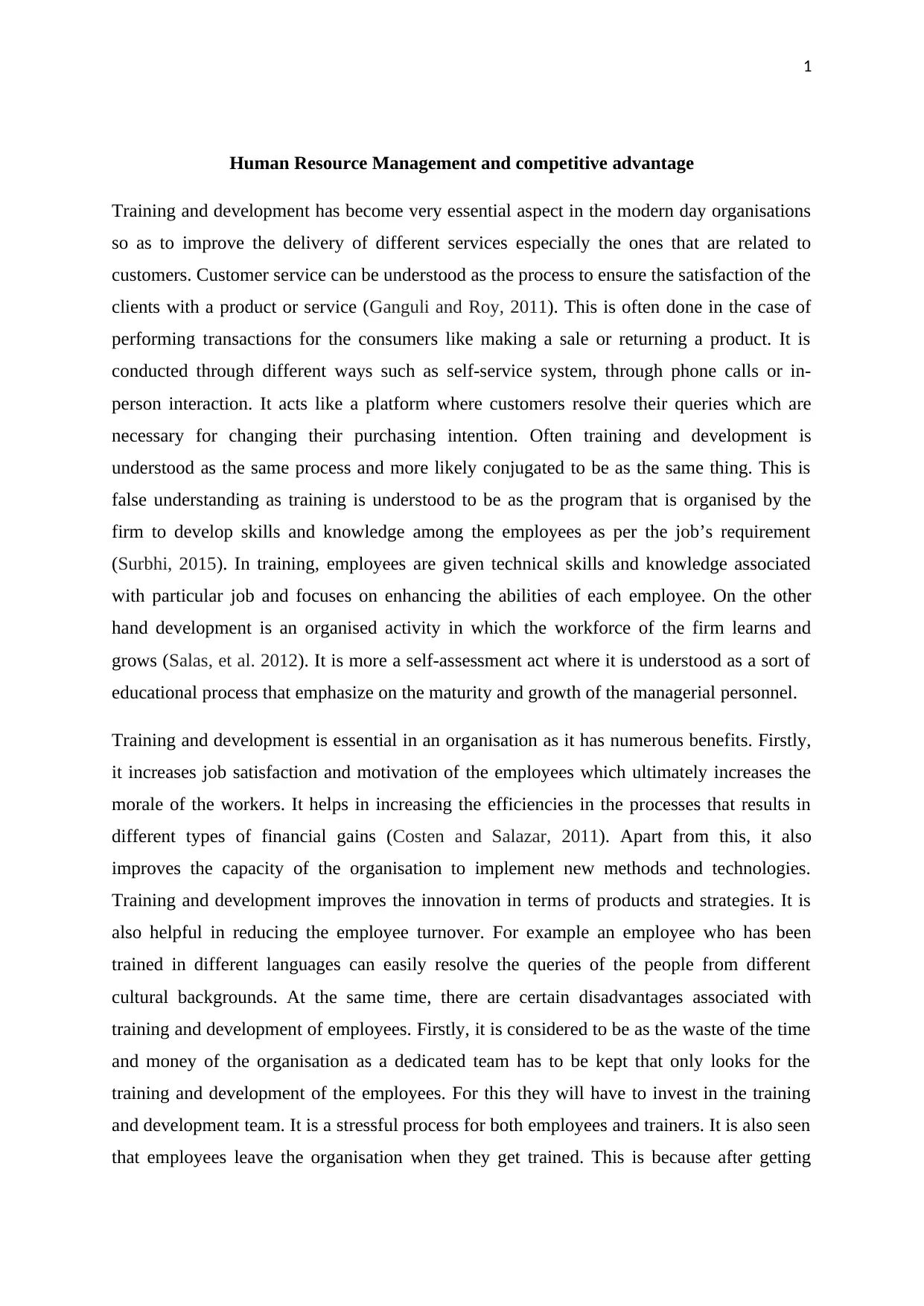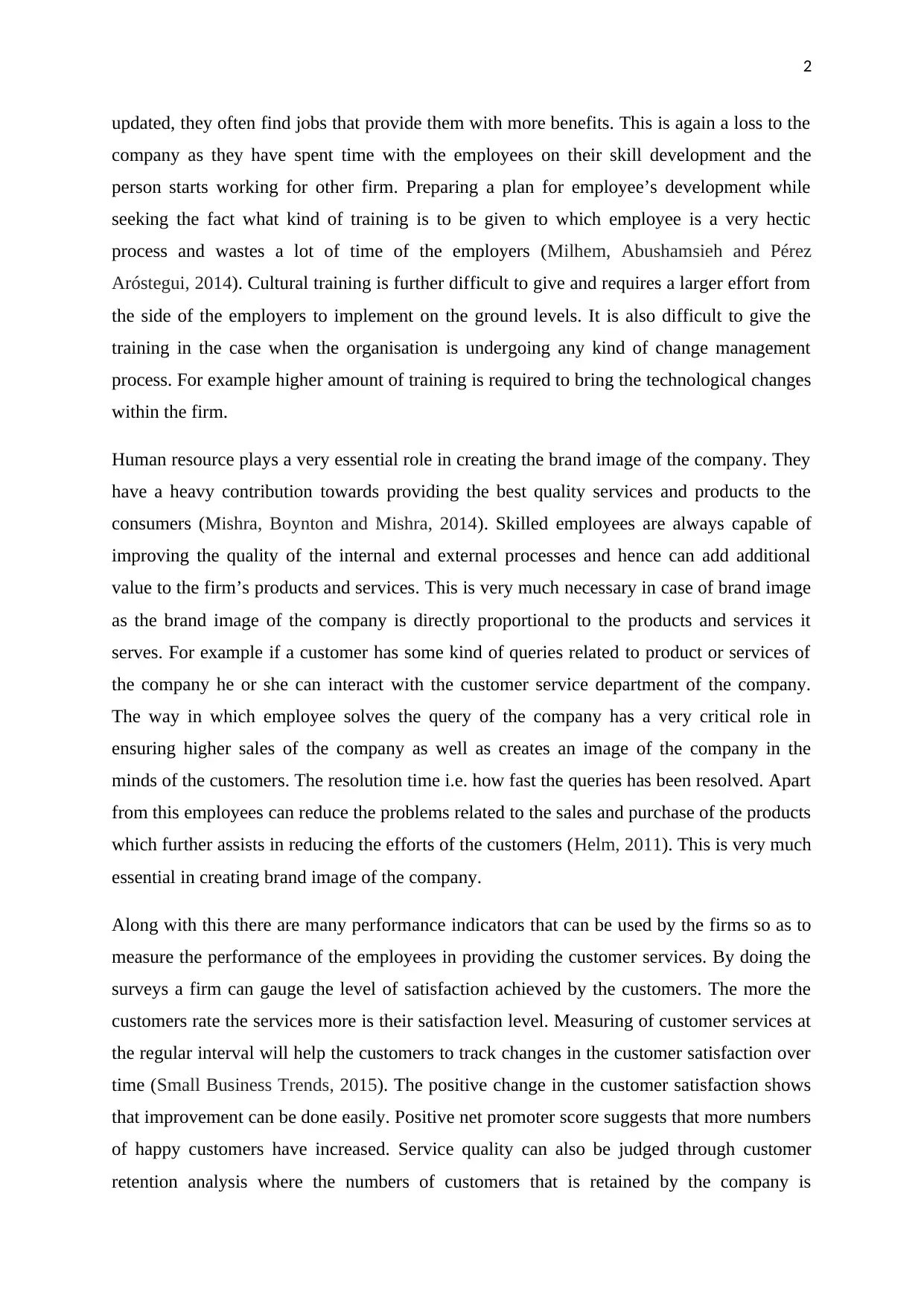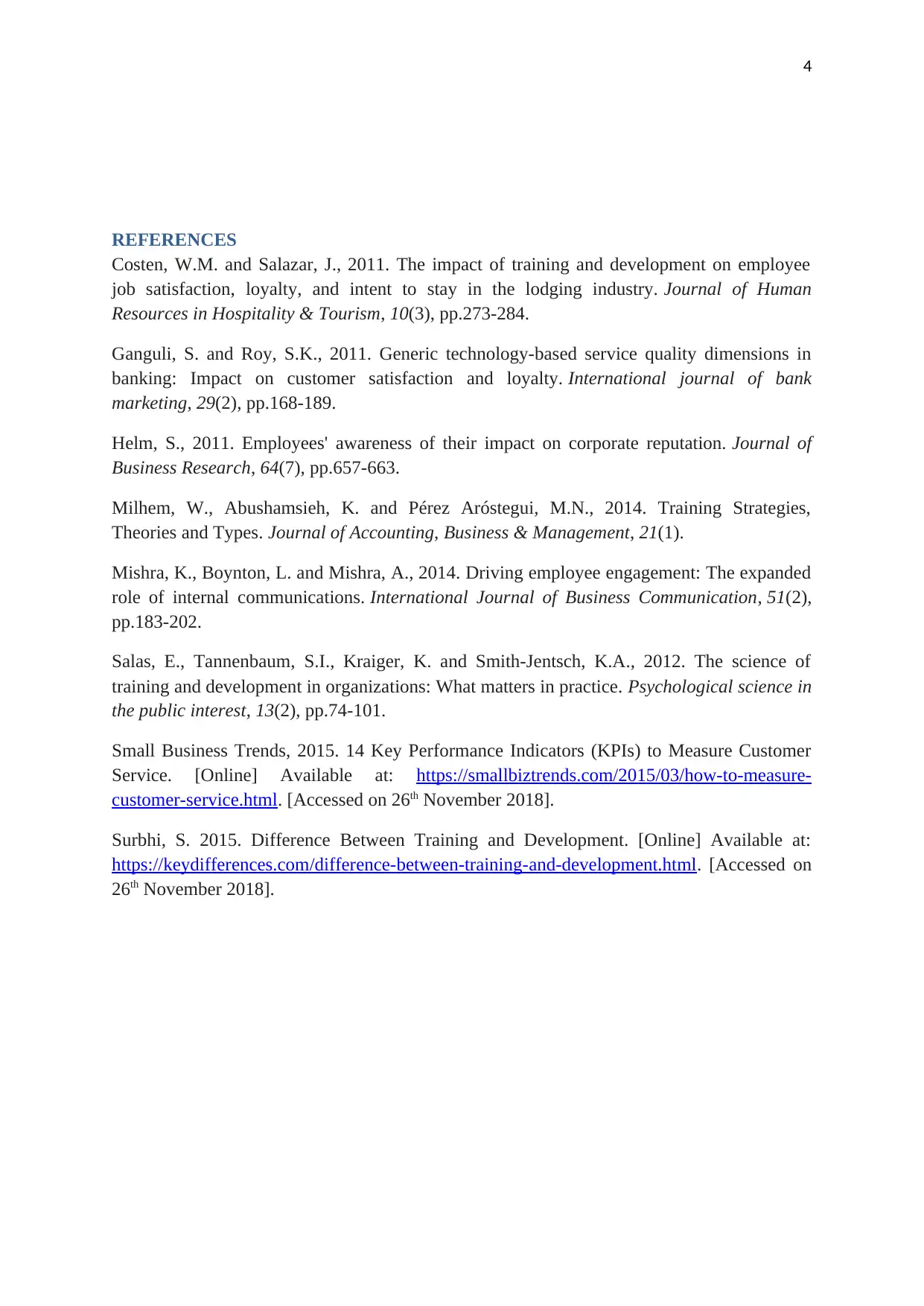How Training & Development Enhances Customer Service: An Essay
VerifiedAdded on 2023/05/30
|5
|1415
|476
Essay
AI Summary
This essay explores the critical role of Human Resource Management (HRM) in fostering superior customer service through effective training and development programs. It begins by defining customer service and differentiating it from training and development, highlighting the benefits such as increased employee motivation, improved efficiency, and enhanced innovation. The essay also acknowledges potential disadvantages, including the costs and the risk of employee turnover. It then delves into the significant contribution employees make to a company's brand image, emphasizing how skilled employees directly influence customer satisfaction and loyalty. The essay concludes by outlining key performance indicators (KPIs) that organizations can use to measure customer service levels, such as customer satisfaction surveys, net promoter scores, and customer retention rates, providing a comprehensive analysis of HRM's impact on organizational success.

ESSAY
Paraphrase This Document
Need a fresh take? Get an instant paraphrase of this document with our AI Paraphraser

1
Human Resource Management and competitive advantage
Training and development has become very essential aspect in the modern day organisations
so as to improve the delivery of different services especially the ones that are related to
customers. Customer service can be understood as the process to ensure the satisfaction of the
clients with a product or service (Ganguli and Roy, 2011). This is often done in the case of
performing transactions for the consumers like making a sale or returning a product. It is
conducted through different ways such as self-service system, through phone calls or in-
person interaction. It acts like a platform where customers resolve their queries which are
necessary for changing their purchasing intention. Often training and development is
understood as the same process and more likely conjugated to be as the same thing. This is
false understanding as training is understood to be as the program that is organised by the
firm to develop skills and knowledge among the employees as per the job’s requirement
(Surbhi, 2015). In training, employees are given technical skills and knowledge associated
with particular job and focuses on enhancing the abilities of each employee. On the other
hand development is an organised activity in which the workforce of the firm learns and
grows (Salas, et al. 2012). It is more a self-assessment act where it is understood as a sort of
educational process that emphasize on the maturity and growth of the managerial personnel.
Training and development is essential in an organisation as it has numerous benefits. Firstly,
it increases job satisfaction and motivation of the employees which ultimately increases the
morale of the workers. It helps in increasing the efficiencies in the processes that results in
different types of financial gains (Costen and Salazar, 2011). Apart from this, it also
improves the capacity of the organisation to implement new methods and technologies.
Training and development improves the innovation in terms of products and strategies. It is
also helpful in reducing the employee turnover. For example an employee who has been
trained in different languages can easily resolve the queries of the people from different
cultural backgrounds. At the same time, there are certain disadvantages associated with
training and development of employees. Firstly, it is considered to be as the waste of the time
and money of the organisation as a dedicated team has to be kept that only looks for the
training and development of the employees. For this they will have to invest in the training
and development team. It is a stressful process for both employees and trainers. It is also seen
that employees leave the organisation when they get trained. This is because after getting
Human Resource Management and competitive advantage
Training and development has become very essential aspect in the modern day organisations
so as to improve the delivery of different services especially the ones that are related to
customers. Customer service can be understood as the process to ensure the satisfaction of the
clients with a product or service (Ganguli and Roy, 2011). This is often done in the case of
performing transactions for the consumers like making a sale or returning a product. It is
conducted through different ways such as self-service system, through phone calls or in-
person interaction. It acts like a platform where customers resolve their queries which are
necessary for changing their purchasing intention. Often training and development is
understood as the same process and more likely conjugated to be as the same thing. This is
false understanding as training is understood to be as the program that is organised by the
firm to develop skills and knowledge among the employees as per the job’s requirement
(Surbhi, 2015). In training, employees are given technical skills and knowledge associated
with particular job and focuses on enhancing the abilities of each employee. On the other
hand development is an organised activity in which the workforce of the firm learns and
grows (Salas, et al. 2012). It is more a self-assessment act where it is understood as a sort of
educational process that emphasize on the maturity and growth of the managerial personnel.
Training and development is essential in an organisation as it has numerous benefits. Firstly,
it increases job satisfaction and motivation of the employees which ultimately increases the
morale of the workers. It helps in increasing the efficiencies in the processes that results in
different types of financial gains (Costen and Salazar, 2011). Apart from this, it also
improves the capacity of the organisation to implement new methods and technologies.
Training and development improves the innovation in terms of products and strategies. It is
also helpful in reducing the employee turnover. For example an employee who has been
trained in different languages can easily resolve the queries of the people from different
cultural backgrounds. At the same time, there are certain disadvantages associated with
training and development of employees. Firstly, it is considered to be as the waste of the time
and money of the organisation as a dedicated team has to be kept that only looks for the
training and development of the employees. For this they will have to invest in the training
and development team. It is a stressful process for both employees and trainers. It is also seen
that employees leave the organisation when they get trained. This is because after getting

2
updated, they often find jobs that provide them with more benefits. This is again a loss to the
company as they have spent time with the employees on their skill development and the
person starts working for other firm. Preparing a plan for employee’s development while
seeking the fact what kind of training is to be given to which employee is a very hectic
process and wastes a lot of time of the employers (Milhem, Abushamsieh and Pérez
Aróstegui, 2014). Cultural training is further difficult to give and requires a larger effort from
the side of the employers to implement on the ground levels. It is also difficult to give the
training in the case when the organisation is undergoing any kind of change management
process. For example higher amount of training is required to bring the technological changes
within the firm.
Human resource plays a very essential role in creating the brand image of the company. They
have a heavy contribution towards providing the best quality services and products to the
consumers (Mishra, Boynton and Mishra, 2014). Skilled employees are always capable of
improving the quality of the internal and external processes and hence can add additional
value to the firm’s products and services. This is very much necessary in case of brand image
as the brand image of the company is directly proportional to the products and services it
serves. For example if a customer has some kind of queries related to product or services of
the company he or she can interact with the customer service department of the company.
The way in which employee solves the query of the company has a very critical role in
ensuring higher sales of the company as well as creates an image of the company in the
minds of the customers. The resolution time i.e. how fast the queries has been resolved. Apart
from this employees can reduce the problems related to the sales and purchase of the products
which further assists in reducing the efforts of the customers (Helm, 2011). This is very much
essential in creating brand image of the company.
Along with this there are many performance indicators that can be used by the firms so as to
measure the performance of the employees in providing the customer services. By doing the
surveys a firm can gauge the level of satisfaction achieved by the customers. The more the
customers rate the services more is their satisfaction level. Measuring of customer services at
the regular interval will help the customers to track changes in the customer satisfaction over
time (Small Business Trends, 2015). The positive change in the customer satisfaction shows
that improvement can be done easily. Positive net promoter score suggests that more numbers
of happy customers have increased. Service quality can also be judged through customer
retention analysis where the numbers of customers that is retained by the company is
updated, they often find jobs that provide them with more benefits. This is again a loss to the
company as they have spent time with the employees on their skill development and the
person starts working for other firm. Preparing a plan for employee’s development while
seeking the fact what kind of training is to be given to which employee is a very hectic
process and wastes a lot of time of the employers (Milhem, Abushamsieh and Pérez
Aróstegui, 2014). Cultural training is further difficult to give and requires a larger effort from
the side of the employers to implement on the ground levels. It is also difficult to give the
training in the case when the organisation is undergoing any kind of change management
process. For example higher amount of training is required to bring the technological changes
within the firm.
Human resource plays a very essential role in creating the brand image of the company. They
have a heavy contribution towards providing the best quality services and products to the
consumers (Mishra, Boynton and Mishra, 2014). Skilled employees are always capable of
improving the quality of the internal and external processes and hence can add additional
value to the firm’s products and services. This is very much necessary in case of brand image
as the brand image of the company is directly proportional to the products and services it
serves. For example if a customer has some kind of queries related to product or services of
the company he or she can interact with the customer service department of the company.
The way in which employee solves the query of the company has a very critical role in
ensuring higher sales of the company as well as creates an image of the company in the
minds of the customers. The resolution time i.e. how fast the queries has been resolved. Apart
from this employees can reduce the problems related to the sales and purchase of the products
which further assists in reducing the efforts of the customers (Helm, 2011). This is very much
essential in creating brand image of the company.
Along with this there are many performance indicators that can be used by the firms so as to
measure the performance of the employees in providing the customer services. By doing the
surveys a firm can gauge the level of satisfaction achieved by the customers. The more the
customers rate the services more is their satisfaction level. Measuring of customer services at
the regular interval will help the customers to track changes in the customer satisfaction over
time (Small Business Trends, 2015). The positive change in the customer satisfaction shows
that improvement can be done easily. Positive net promoter score suggests that more numbers
of happy customers have increased. Service quality can also be judged through customer
retention analysis where the numbers of customers that is retained by the company is
⊘ This is a preview!⊘
Do you want full access?
Subscribe today to unlock all pages.

Trusted by 1+ million students worldwide

3
calculated. Along with this conversion rate in terms of how many customers actually make a
purchase after the interaction is evaluated. Average resolution time so as to find out the time
that company has taken to resolve any issue is calculated. For example when a person at
customer services is able to provide the answers to the questions is lesser time, it always
understood as the good customer service. This is also beneficial in terms of the fact that quick
resolution of issues helps in resolving higher numbers of queries.
calculated. Along with this conversion rate in terms of how many customers actually make a
purchase after the interaction is evaluated. Average resolution time so as to find out the time
that company has taken to resolve any issue is calculated. For example when a person at
customer services is able to provide the answers to the questions is lesser time, it always
understood as the good customer service. This is also beneficial in terms of the fact that quick
resolution of issues helps in resolving higher numbers of queries.
Paraphrase This Document
Need a fresh take? Get an instant paraphrase of this document with our AI Paraphraser

4
REFERENCES
Costen, W.M. and Salazar, J., 2011. The impact of training and development on employee
job satisfaction, loyalty, and intent to stay in the lodging industry. Journal of Human
Resources in Hospitality & Tourism, 10(3), pp.273-284.
Ganguli, S. and Roy, S.K., 2011. Generic technology-based service quality dimensions in
banking: Impact on customer satisfaction and loyalty. International journal of bank
marketing, 29(2), pp.168-189.
Helm, S., 2011. Employees' awareness of their impact on corporate reputation. Journal of
Business Research, 64(7), pp.657-663.
Milhem, W., Abushamsieh, K. and Pérez Aróstegui, M.N., 2014. Training Strategies,
Theories and Types. Journal of Accounting, Business & Management, 21(1).
Mishra, K., Boynton, L. and Mishra, A., 2014. Driving employee engagement: The expanded
role of internal communications. International Journal of Business Communication, 51(2),
pp.183-202.
Salas, E., Tannenbaum, S.I., Kraiger, K. and Smith-Jentsch, K.A., 2012. The science of
training and development in organizations: What matters in practice. Psychological science in
the public interest, 13(2), pp.74-101.
Small Business Trends, 2015. 14 Key Performance Indicators (KPIs) to Measure Customer
Service. [Online] Available at: https://smallbiztrends.com/2015/03/how-to-measure-
customer-service.html. [Accessed on 26th November 2018].
Surbhi, S. 2015. Difference Between Training and Development. [Online] Available at:
https://keydifferences.com/difference-between-training-and-development.html. [Accessed on
26th November 2018].
REFERENCES
Costen, W.M. and Salazar, J., 2011. The impact of training and development on employee
job satisfaction, loyalty, and intent to stay in the lodging industry. Journal of Human
Resources in Hospitality & Tourism, 10(3), pp.273-284.
Ganguli, S. and Roy, S.K., 2011. Generic technology-based service quality dimensions in
banking: Impact on customer satisfaction and loyalty. International journal of bank
marketing, 29(2), pp.168-189.
Helm, S., 2011. Employees' awareness of their impact on corporate reputation. Journal of
Business Research, 64(7), pp.657-663.
Milhem, W., Abushamsieh, K. and Pérez Aróstegui, M.N., 2014. Training Strategies,
Theories and Types. Journal of Accounting, Business & Management, 21(1).
Mishra, K., Boynton, L. and Mishra, A., 2014. Driving employee engagement: The expanded
role of internal communications. International Journal of Business Communication, 51(2),
pp.183-202.
Salas, E., Tannenbaum, S.I., Kraiger, K. and Smith-Jentsch, K.A., 2012. The science of
training and development in organizations: What matters in practice. Psychological science in
the public interest, 13(2), pp.74-101.
Small Business Trends, 2015. 14 Key Performance Indicators (KPIs) to Measure Customer
Service. [Online] Available at: https://smallbiztrends.com/2015/03/how-to-measure-
customer-service.html. [Accessed on 26th November 2018].
Surbhi, S. 2015. Difference Between Training and Development. [Online] Available at:
https://keydifferences.com/difference-between-training-and-development.html. [Accessed on
26th November 2018].
1 out of 5
Related Documents
Your All-in-One AI-Powered Toolkit for Academic Success.
+13062052269
info@desklib.com
Available 24*7 on WhatsApp / Email
![[object Object]](/_next/static/media/star-bottom.7253800d.svg)
Unlock your academic potential
Copyright © 2020–2025 A2Z Services. All Rights Reserved. Developed and managed by ZUCOL.





